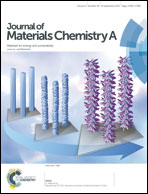Mn-doped Co2(OH)3Cl xerogels with 3D interconnected mesoporous structures as lithium ion battery anodes with improved electrochemical performance†
Abstract
Considering the merits of 3D mesoporous interconnected structures with a large surface area of xerogel and high theoretical capacity of Co2(OH)3Cl, which incorporates both chlorine and hydroxyl functional groups simultaneously, it is of great fundamental importance, as well as a challenge, to tune the porous structure, surface area, and functional doping to enhance the electrochemical performance of Co2(OH)3Cl xerogel anodes for lithium ion batteries (LIBs). Herein, for the first time, we report Mn-doped Co2(OH)3Cl 3D mesoporous xerogels assembled from nanoparticles via a one-step sol–gel method. The effect of Mn doping on the microstructures, surface area, charge transfer kinetics, and electrochemical performance of Mn-doped Co2(OH)3Cl xerogels was systematically investigated. It was observed that 4% Mn-doped Co2(OH)3Cl xerogels display excellent electrochemical performance, with a superior capacity of 1377 mA h g−1 after 50 cycles at a current density of 100 mA g−1. Even when the current density was increased to 1600 mA g−1, it still retained a capacity of 824 mA h g−1. The great enhancement in the electrochemical performance can be mainly due to the uniquely special 3D hierarchically porous interconnected xerogel structure with a high surface area, the enhancement of the electric conductivity and charge transfer kinetics, and the activated redox reaction kinetics related to LiOH and LiCl for the Mn-doped Co2(OH)3Cl xerogels.


 Please wait while we load your content...
Please wait while we load your content...